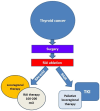Pathogenesis and Management Strategies in Radioiodine-Refractory Differentiated Thyroid Cancer: From Molecular Mechanisms Toward Therapeutic Approaches: A Comprehensive Review
- PMID: 39685621
- PMCID: PMC11641973
- DOI: 10.3390/jcm13237161
Pathogenesis and Management Strategies in Radioiodine-Refractory Differentiated Thyroid Cancer: From Molecular Mechanisms Toward Therapeutic Approaches: A Comprehensive Review
Abstract
Thyroid cancer (TC) remains the most common cancer in endocrinology. Differentiated thyroid cancer (DTC), the most common type of TC, generally has a favorable outlook with conventional treatment, which typically includes surgery along with radioiodine (RAI) therapy and thyroid-stimulating hormone (TSH) suppression through thyroid hormone therapy. However, a small subset of patients (less than 5%) develop resistance to RAI. This resistance occurs due to the loss of Na/I symporter (NIS) activity, which is crucial for iodine absorption in thyroid cells. The decline in NIS activity appears to be due to gene modifications, reconfigurations with irregular stimulation of signaling pathways such as MAPK and PI3K/Akt pathways. These molecular changes lead to a diminished ability of DTC cells to concentrate iodine, which makes RAI therapy ineffective. As a consequence, patients with radioiodine-refractory DTC require alternative treatments. Therapy with tyrosine kinase inhibitors (TKIs) has emerged as the primary treatment option to inhibit proliferation and growth of RAIR-DTC, targeting the pathways responsible for tumor progression. In this article, we analyze molecular processes responsible for RAI resistance and explore both conventional and emerging therapeutic strategies for managing RAIR-DTC, aiming to improve patient outcomes.
Keywords: NIS; RAIR-DTC; differentiated thyroid cancer; iodine therapy; signal pathways; surgery; tyrosine kinase inhibitors.
Conflict of interest statement
The authors declare no conflicts of interest.
Figures




Similar articles
-
Pathogenesis and signaling pathways related to iodine-refractory differentiated thyroid cancer.Front Endocrinol (Lausanne). 2024 Jan 19;14:1320044. doi: 10.3389/fendo.2023.1320044. eCollection 2023. Front Endocrinol (Lausanne). 2024. PMID: 38313845 Free PMC article. Review.
-
Radioactive Iodine-Refractory Differentiated Thyroid Cancer and Redifferentiation Therapy.Endocrinol Metab (Seoul). 2019 Sep;34(3):215-225. doi: 10.3803/EnM.2019.34.3.215. Endocrinol Metab (Seoul). 2019. PMID: 31565873 Free PMC article. Review.
-
Enhancing radioactive iodine (RAI) incorporation in RAI-refractory differentiated thyroid cancer: current insights.Eur Thyroid J. 2025 Mar 24;14(2):e240319. doi: 10.1530/ETJ-24-0319. Print 2025 Apr 1. Eur Thyroid J. 2025. PMID: 40067410 Free PMC article. Review.
-
Mitogen-Activated Protein Kinase Pathway Inhibition for Redifferentiation of Radioiodine Refractory Differentiated Thyroid Cancer: An Evolving Protocol.Thyroid. 2019 Nov;29(11):1634-1645. doi: 10.1089/thy.2019.0143. Thyroid. 2019. PMID: 31637953
-
Radioiodine therapy in advanced differentiated thyroid cancer: Resistance and overcoming strategy.Drug Resist Updat. 2023 May;68:100939. doi: 10.1016/j.drup.2023.100939. Epub 2023 Feb 8. Drug Resist Updat. 2023. PMID: 36806005 Review.
References
-
- Durante C., Haddy N., Baudin E., Leboulleux S., Hartl D., Travagli J.P., Caillou B., Ricard M., Lumbroso J.D., De Vathaire F., et al. Long-Term Outcome of 444 Patients with Distant Metastases from Papillary and Follicular Thyroid Carcinoma: Benefits and Limits of Radioiodine Therapy. J. Clin. Endocrinol. Metab. 2006;91:2892–2899. doi: 10.1210/jc.2005-2838. - DOI - PubMed
Publication types
Grants and funding
LinkOut - more resources
Full Text Sources
Research Materials

